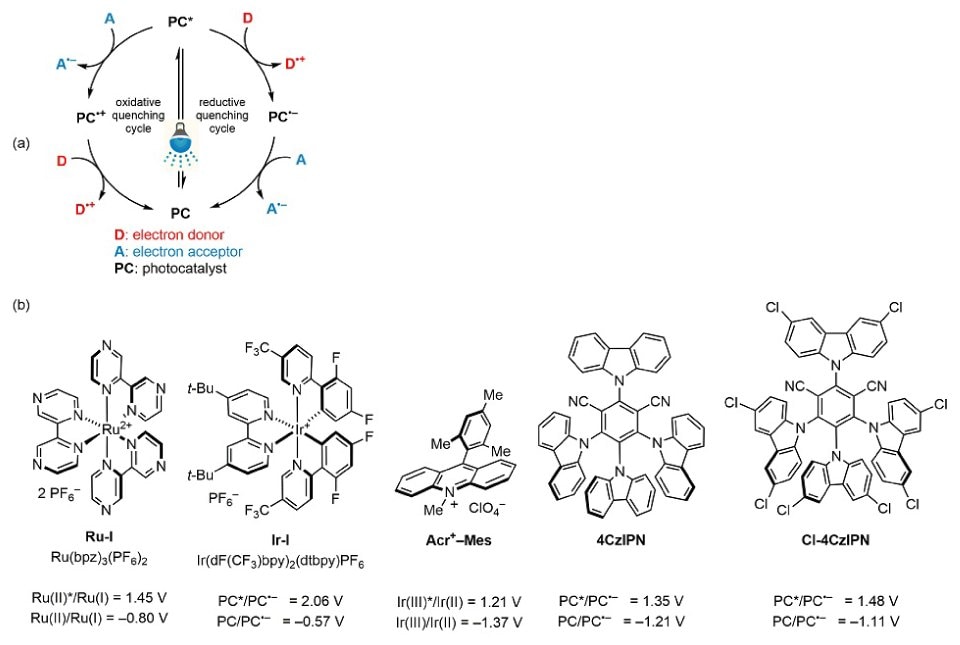Single-Electron Oxidation-Induced Chemical Transformations: Carbon-Carbon Bond Formation and Selective Oxaziridine Rearrangement
Shafrizal Rasyid Atriardi, and Sang Kook Woo*
Department of Chemistry University of Ulsan, 93 Daehak-Ro Nam-gu, Ulsan 44610, Republic of Korea
Abstract
Visible-light photoredox catalysis is an important and growing research area in the field of green and sustainable organic synthesis. One of the main mechanisms involved in photoredox catalysis is single-electron transfer (SET), which has been extensively investigated in our group for the development of greener carbon–carbon bond forming reactions and oxaziridine rearrangement. In this review, we highlight our results on the development and application of neutral silicon radical precursors for the generation of alkyl radicals and the selective rearrangement of oxaziridines into nitrones or amides.
Introduction
In the past decade, visible-light photoredox catalysis has received significant attention in the field of sustainable organic synthesis because of its inexpensive, abundant, and clean light sources and mild reaction conditions, which have led to the development of many organic reactions that are facilitated by visible-light photocatalysts.1 Single-electron transfer (SET), in which radical species are produced, is one of the main mechanisms by which photoredox catalysis takes place. The SET mechanism can be classified into oxidative and reductive quenching cycles according to the redox state of the catalyst in the catalytic cycle (Figure 1, Part (a)).1b,f,2 The spontaneity of the SET mechanism can be easily predicted from the Gibbs energy of a photoinduced electron transfer (ΔGPET = −F[Ered(A/A•−) − Eox(D•+/D)] − w − ΔE0,0), where the redox potentials of catalysts and substrates can be obtained from the literature or determined through cyclic voltammetry. Our research has focused on the use of SET in photoredox catalysis for carbon–carbon bond forming reactions and oxaziridine rearrangement using transition-metal-based and organic photocatalysts such as Ru(bpz)3(PF6)2, Ir(dF(CF3)ppy)2(dtbpy)PF6, Fukuzumi’s acridinium salt (Acr+–Mes), 2,4,5,6-tetrakis(9H-carbazol-9-yl)-isophthalonitrile (4CzIPN), and 2,4,5,6-tetrakis(3,6-dichloro-9H-carbazol-9-yl)isophthalonitrile (Cl-4CzIPN), which are good oxidizers (Figure 1, Part (b)). In particular, we have favored organic photocatalysts because of their low cost and easy preparation. In this review, we present the results of our investigations of neutral silicon-based radical precursors for the generation of alkyl radicals via SET and the selective rearrangement of oxaziridines into nitrones or amides.

Figure 1. (a) Single-Electron Transfer (SET) Mechanism. (b) Popular Oxidizer Photocatalysts. (Ref. 1)
Conclusion
In this review, we have summarized our contributions to the development of greener and more sustainable reactions proceeding via a SET mechanism in photoredox catalysis for the formation of carbon–carbon bonds and the rearrangement of oxaziridines. We have developed neutral, silicon-based precursors of alkoxymethyl, hydroxymethyl, and allylic radicals and used them in Giese reactions, RPC reactions, and imine addition reactions to form new carbon–carbon bonds. These reactions provide access to a wide range of valuable scaffolds such as ethers, alcohols, 2,3-dihydrofurans, α-cyano-γ-butyrolactones, γ-butyrolactones, allylic compounds, gem-difluoroalkenes, β-amino ethers, and β-amino alcohols. We have also demonstrated the selective rearrangement of oxaziridines into nitrones and amides under photocatalytic conditions. The rearrangement of oxaziridines to nitrones was selectively observed in acetonitrile, ethyl acetate, and acetone as solvents, while amides were formed through a weak-base–promoted rearrangement that utilizes weak bases such as CF3CO2− and DMF. Our ongoing research efforts aim to further improve silicon-based alkyl radical precursors for the generation and utilization of various alkyl radicals and to further explore the chemical conversion of oxaziridines. It is our sincere hope that our research will contribute to the expansion of ecologically friendly organic synthesis.
Acknowledgments
This work was supported by a National Research Foundation of Korea (NRF) grant funded by the Korean government (MSIT) (NRF-2022R1A2C1005108 and 2021R1A4A1027480).
Trademarks. Amberlite® (TDDP Specialty Electronic Materials US 8, LLC).
Related Products
References
To continue reading please sign in or create an account.
Don't Have An Account?